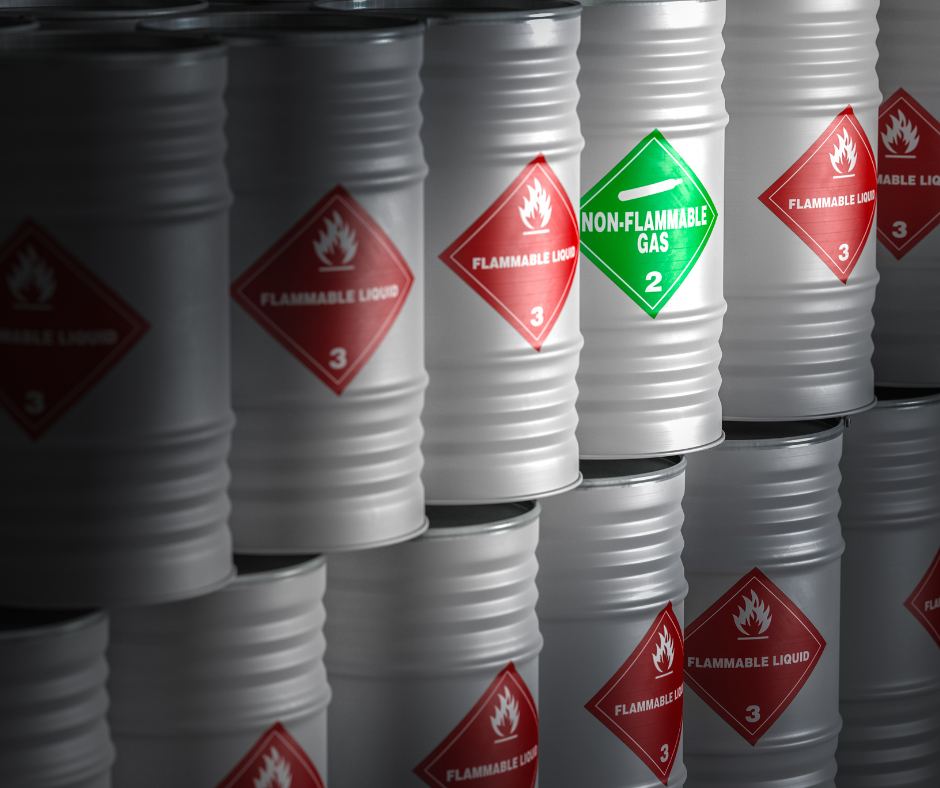What Is A Class 1 Flammable Liquid?
Class 1 flammable liquids are extensively used in various industrial applications, yet their usage carries inherent dangers that require special...
5 min read
 Larry Burton
:
Apr 4, 2024 10:33:00 AM
Larry Burton
:
Apr 4, 2024 10:33:00 AM

Fire safety is a critical aspect of industrial and everyday life, and it involves classifying materials based on their flammability and combustibility. Understanding their fire classification is crucial for ensuring safety in your work environment.
Unsurprisingly, many facilities that regularly deal with dangerous substances ask: Flammable and combustible liquids fall into which fire classification?
The National Fire Protection Association (NFPA) classifies flammable and combustible liquids in six classes: I-A, I-B, I-C, II, III-A and III-B.
For the safety of your employees and the protection of your facilities, companies must be aware of the specific classification of liquids you use, ensuring proper storage, handling, disposal and adherence to safety protocols.
Flammable liquids are substances that can easily ignite and burn rapidly at normal temperatures. They have a low flash point, which is the lowest temperature at which a liquid can produce enough vapor to form an ignitable mixture in the air.
point, which is the lowest temperature at which a liquid can produce enough vapor to form an ignitable mixture in the air.
Combustible liquids, while still capable of catching fire, have a higher flash point compared to flammable liquids. They require higher temperatures to ignite, but once ignited, they can burn and sustain a fire.
The National Fire Protection Association hazard classifications for flammable and combustible materials are listed below:
Hazard classification for flammable liquids
|
Class |
Flash Point |
Boiling Point |
Examples |
|
I-A |
below 73°F (23°C) |
below 100°F (38°C) |
diethyl ether, pentane, ligroin, petroleum ether |
|
I-B |
below 73°F (23°C) |
at or above 100°F (38°C) |
acetone, benzene, cyclohexane, ethanol |
|
I-C |
73-100°F (24-38°C) |
---- |
p-xylene |
Hazard classification for combustible liquids
|
Class |
Flash Point |
Boiling Point |
Examples |
|
II |
101-140°F (39-60°C) |
---- |
diesel fuel, motor oil, kerosene, cleaning solvents |
|
III-A |
141-199°F (61-93°C) |
---- |
paints (oil base), linseed oil, mineral oil |
|
III-B |
200°F (93°C) or above |
---- |
paints (oil base), neatsfoot oil |
Understanding the different flash points and boiling points of flammable and combustible liquids is essential for businesses that handle dangerous substances for these reasons:
A comprehensive understanding of the flash points and boiling points of flammable and combustible liquids empowers businesses to implement effective safety measures, prevent fires and ensure the well-being of employees and the integrity of their operations. This knowledge forms the foundation for a robust safety culture within the organization.
While there are some general best practices all companies that store flammable and combustible liquids should follow, there are specific requirements for each subclassification listed in the chart above.
|
Type |
Class I-A |
Class I-B |
Class I-C |
Class II |
Class III-A – B |
|
Glass or approved plastic containers |
1 pint (0.47L) |
1 quart (0.94L) |
1 gallon (3.79L) |
1 gallon (3.79L) |
1 gallon (3.79L) |
|
Metal containers |
1 gallon (3.79L) |
5 gallon (18.95L) |
5 gallon (18.95L) |
5 gallon (18.95L) |
5 gallon (18.95L) |
|
OSHA compliant safety cans |
2 gallon (7.58L) |
5 gallon (18.95L) |
5 gallon (18.95L) |
5 gallon (18.95L) |
5 gallon (18.95L) |
Source: UC San Diego
There are a few exceptions to the above guidelines. For example, glass or approved plastic containers up to 1 gallon may be used for flammable liquids when the liquid may corrode metal containers or when the metal container could affect the analytical standard of the liquid.
It is important for a company to determine the type and size of storage containers allowed based on how that particular liquid is classified so that you can meet all state and federal regulations.
Other best practices for storing flammable and combustible liquids to help prevent fires and other types of accidents include:
include:
It’s also critical to make sure every employee is trained in properly stacking, transporting and storing any flammable or combustible liquids on site, as well as to create a Hazardous Material Business Plan (HMBP). This plan provides important information about the hazardous materials on site and is critical for when first responders arrive on site in the event an emergency occurs.
The safe transportation and disposal of chemicals relies on knowing the fire classification of flammable and combustible liquids. For example, regulatory agencies, including the Department of Transportation (DOT), have specific regulations governing the transportation of hazardous materials, including flammable and combustible liquids. Understanding the fire classification ensures compliance with transportation guidelines, which include proper labeling, packaging and documentation.
Any company you partner with should be licensed to transport hazardous wastes in your state. Samex Environmental only accepts waste from brokers that work with licensed hazardous waste transporters in the United States.
Another significant decision you must make is where to send your waste. Solvent distillation offers businesses an opportunity to meet their sustainability objectives while safely disposing of flammable or combustible spent solvents.
The solvent distillation process takes a liquid or vapor mixture of two or more substances and separates it into its component fractions of desired purity. Through the application of heat, this process separates the solvents from other substances. By heating a liquid mixture containing solvents, the solvent vaporizes. The vapor is then condensed back into a liquid form, resulting in the separation and recovery of the solvent.
At Samex, we focus on ensuring nothing is wasted so that companies achieve the highest level of sustainability possible for the waste that they generate. Any still bottoms that are generated during the solvent distillation process are transferred to our fuel blending area where they are blended with other flammable liquids. This process meets the specifications of the cement kiln that will use the blend as an alternative fuel source.
Samex also operates a water treatment plant on the same site where commercially clean nonhazardous water is repurposed to brick manufacturing. Solid byproducts from the treatment process are sent to the fuel blending area where they become part of the repurposed waste destined to the cement kiln to be used as an alternative fuel.
By choosing this sustainable option for your flammable or combustible waste, you not only benefit from efficient waste management but also contribute to creating a better environment through responsible waste disposal practices.
.png)
Class 1 flammable liquids are extensively used in various industrial applications, yet their usage carries inherent dangers that require special...
.png)
Dealing with flammable liquids requires more than just caution. It demands a proactive approach to safety.
.png)
When handling flammable liquids in a factory setting, proper storage is not just a matter of convenience. It’s a critical safety measure that helps...